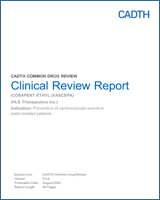Disease Background
CVD is the leading cause of death in the adult population globally and an economic burden for health care systems, affecting the majority of people older than 60 years and accounting for half of all non-communicable diseases worldwide.3 In Canada, CVD is the second leading cause of death (after cancer) and the leading cause of hospitalization. It is also the leading cause of years of life lost, and the second leading cause of disability-adjusted life-years lost (the number of years lost due to ill health, disability, or early death).4 Approximately 2.4 million Canadians over the age of 20 live with a diagnosed heart condition.
Atherosclerosis is accepted as the main underlying condition leading to CV events.5,6 Dyslipidemia, particularly hypercholesterolemia involving LDL-c and VLDL-c as well as hypertriglyceridemia, is causally linked to atherosclerosis.7,8
Hypertriglyceridemia is a frequent lipid abnormality usually appearing in persons who are obese (with or without insulin resistance), and in those who have type 2 diabetes mellitus or metabolic syndrome. It is defined as mild hypertriglyceridemia when fasting TG levels are 1.7 to 5.6 mmol/L (150 to 499 mg/dL), moderate when levels fall between 5.6 to 10.0 mmol/L (500 to 886 mg/dL), and very high or severe when levels are higher than 10.0 mmol/L (886 mg/dL).9 According to the Canadian Health Measures Survey (2007–2009), the prevalence of dyslipidemia is 23% for those aged 18 to 39, 40% in those aged 40 to 59, and 59% in those 60 to 79 years old.10
Current evidence syntheses and individual studies have demonstrated a 20% to 22% relative risk reduction in CV events for each 1 mmol/L reduction in LDL-c.11 Hence, reducing dyslipidemia has been a cornerstone approach of clinicians and a main goal specified in clinical guidelines and recommendations around the world.
Standards of Therapy
The main goal of treating lipid disorders is to prevent and/or reduce CV mortality and morbidity — mainly MI, stroke, and need for revascularization — associated with high lipid levels. The therapeutic options for lowering TGs include lifestyle modifications (such as weight control, avoiding smoking and alcohol overuse, and diet management) and medications.
Systematic reviews of randomized trials have shown that LDL-lowering therapy with beta-hydroxy beta-methylglutaryl-CoA (HMG-CoA) reductase inhibitors (statins) reduces the risk of CV events (including stroke) and overall mortality in patients with CV risk factors.12 Together with other therapies and lifestyle modifications, these are considered first-line medications in most guidelines.11 Further treatment with niacin, fibrates, or fish oils is available; however, adding these drugs to statin treatment has not demonstrated CV benefits in high-risk patients with persisting dyslipidemia. This subgroup of patients may still present with CV events (8.5% in 3.8 years).13,14
Evidence from observational studies in Western and Asian populations have shown an association between regular fish consumption and lower rates of coronary heart disease.15,16 These findings stemmed from initial observations in populations that consumed high amounts of foods rich in very-long-chain polyunsaturated fatty acids containing omega-3 fatty acids, including EPA and DHA, usually found in fish and other seafood. However, a recent systematic review including 10 randomized controlled trials found little to no effect of omega-3 fatty acid supplements on fatal or non-fatal coronary heart disease or any MACE.17 All included randomized trials, however, used combinations of DHA and EPA in different proportions and doses. Based on recent evidence, some have proposed that DHA and EPA might have different effects and impact on patients at high risk of CVD or with established CVD who are already on statins.18,19
Drug
Icosapent ethyl (Vascepa) is an ethyl ester — a highly purified version — of EPA currently pending approval from Health Canada at the time of drafting this report. The indication is to reduce the risk of CV events (CV death, non-fatal MI, non-fatal stroke, coronary revascularization, or hospitalization for unstable angina) in statin-treated patients with elevated TG levels who are at high risk of CV events due to established CVD, or diabetes and at least one other CV risk factor. The drug is undergoing an expedited (priority) review with Health Canada. The sponsor’s reimbursement request is as per the anticipated indication. Icosapent ethyl is supplied as a 1 g liquid-filled soft gelatin capsule for oral administration with a recommended dose of 4 g per day, as two 1 g capsules twice a day. This product has not been previously evaluated by CADTH.
The mechanism of action of icosapent ethyl is still not completely understood. It has been suggested that anti-oxidant and anti-inflammatory properties of icosapent ethyl result in reduced or slowed progression of the atherosclerotic process.20 Non-conclusive reproductive and developmental studies suggest potential for direct harm to fetal development and reproductive maturation; therefore, icosapent ethyl should be avoided during pregnancy and during lactation, as specified in the product monograph. presents the characteristics of icosapent ethyl and its main comparators for the purpose of this review.
Key Characteristics of Icosapent Ethyl and Main Comparators — Fish Oil, Niacin, Ezetimibe, and Fibrates.

